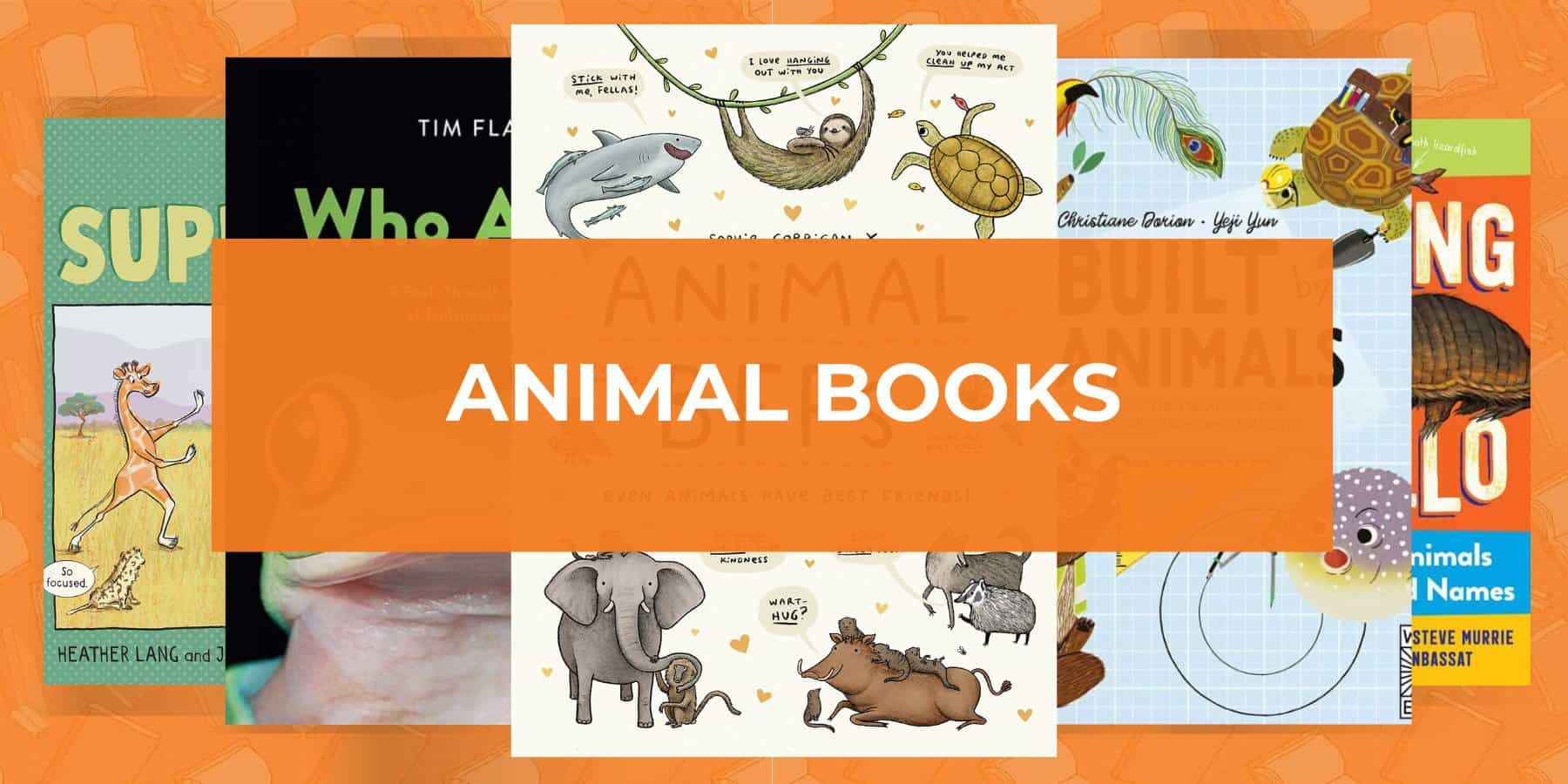20 Best Books About Nocturnal Animals
This post may contain affiliate links.
Do your kids know about nocturnal animals? Nocturnal animals are animals who sleep during the day and are active during the night. Learn more about nocturnal animals like bats, owls, foxes, and raccoons in these illuminating children’s books about the world of the dark.
Some nocturnal animals are more active during dawn and dusk. The word for this is crepuscular. These crepuscular animals include elephants, kangaroos, and red foxes.
Of course, the opposite of nocturnal is diurnal; animals are most active during the daylight and sleep at night. This post is not about them.
Animals who are active in the dark avoid predators or are predators and use the dark for hunting.
Sometimes, nocturnal animals prefer the cooler temperatures of the night.
Nocturnal animals have adaptations to help them live in the dark, including low-light sight so they can see in the dark, acute hearing or echolocation, or a strong sense of smell. These help the animals find food and avoid danger.
“To all of you who crawl and creep,
who buzz and chirp and hoot and peep,
who wake at dusk and throw off sleep:
Welcome to the night.”
– Joyce Sidman, “Welcome to the Night” in Dark Emperor & Other Poems of the Night

Want a list of nocturnal animals? Here are some of our favorites.
- aardvark
- armadillo
- badger
- bat
- cat
- crocodile
- elephant
- firefly
- flying squirrel
- fox
- hamster
- hedgehog
- kangaroo
- koala
- leopard
- mountain lion
- moth
- opossum
- owl
- platypus
- porcupine
- possum
- rabbit
- raccoon
- shark
- wolf
Books About Nocturnal Animals

Little Owl’s Night by Divya Srinivasan
“Little Owl was having a wonderful night.” He watches the animals in the forest — the possum family waddling along, the hedgehog sniffing a mushroom patch, the skunk nibbling at berries, the cricket singing, and the frog croaking. Little Owl can’t imagine how daytime could be better than the wonderful nighttime. A beautiful and reassuring depiction of the world at night.

Who’s Who in the Woods? A Pop-Up Mystery by Eryl Norris and Andy Mansfield
Just who do the eyes belong to? Black and white pop-up creatures, that’s who.

Fox Explores the Night by Martin Jenkins, illustrated by Richard Smythe
A nocturnal fox searches for food in a busy city. She finds supper in someone’s backyard then returns home. It’s a purposefully simple book with guided questions in the back such as “Can you find examples of different light sources in the book?“

Night Animals by Gianna Marino
The animals are hiding, keeping safe from the scary stuff in the dark . . . until all the animals learn that THEY are night animals and accidentally scare two kids camping in a tent.

As Night Falls Creatures That Go Wild After Dark by Donna Jo Napoli, illustrated by Felicita Sala
Playful and exuberant, see which animals are awake at night. And then, learn about who eats what…Spiders eat goby fish; bumblebee bats eat spiders; racer snakes eat bats… Nimble weasels sneak and snatch, golden jackals pounce and crunch, and tigers eat what they want- all the other animals! Napoli relates these nocturnal wild animals to you– just like when you want to prowl around your room or jump on pillows at night.

The Night World by Mordicai Gerstein
A boy and his cat leave their house for the dark night outside. Slowly the shadows reveal a variety of animals who are awake. Mostly black and white illustrations with flashes of colored eyes really stand out in the dim light.

Fiona the Fruit Bat by Dan Riskin, illustrated by Rachel Qiuqi
I love this mesmerizing story of a young fruit bat who is ready to take her first flight–and doesn’t understand why she needs to listen. Listen to what? As Fiona explores the world, she begins to understand how echolocation helps her hear where she is. I like the way the illustrations go from dark to light and the great example of growth mindset.

You Are a Raccoon! by Laurie Ann Thompson, illustrated by Jay Fleck
Written in the second person point of view, you are a raccoon. As you read, you’ll learn about your family and den and sounds. Read about getting bigger, finding food, and waking at night with other nocturnal animals. Playful verbs invite you to act out raccoon actions. A must-read for preschoolers; it’s informative, interactive, and fun.

Moonlight Animals by Elizabeth Golding, illustrated by Ali Lodge
Readers, look for the hidden nocturnal animals using the enclosed cardboard flashlight! Then read facts about each one.

Daylight Starlight Wildlife by Wendell Minor
Gorgeous illustrations help children walk through the day and night. You’ll learn about diurnal (daytime) and nocturnal (nighttime) animals. Each animal mentioned is listed in the back with information about their life and what they eat.

Owl Bat Bat Owl by Marie-Louise Fitzpatrick
A family of owls is resting comfortably on a tree branch. Much to the mama owl’s dismay, they’re joined by a family of bats, which mirrors the owl’s positions –only upside down. It takes a wind storm and the mother’s love to bring these two nocturnal families together in friendship.

Goodnight, Butterfly by Ross Burach
Butterfly meets a nocturnal animal, and he has SO MANY questions…which are hilarious to us and annoying to his new porcupine friend, who prefers quiet. To help Butterfly sleep, Porcupine suggests a good book. It doesn’t work. Then, he recommends Butterfly think calming thoughts. Eventually, Butterfly goes to sleep, but his snoring wakes up all the other butterflies. A delightful read-aloud for bedtime or anytime!

Prickly Hedgehogs! by Jane McGuinness
The author does an incredible job at making this informational book read like a narrative story, which makes it more accessible for younger readers. Learn about hedgehogs, nocturnal animals, by following a mama hedgehog and her growing babies. I also love the use of onomatopoeia throughout the book and the incredible illustrations. Very well-done!
“He might be small, but Little Hedgehog has a big appetite. Sometimes he walks a whole mile in one night . . .
sniff-sniff-sniffing for things to eat.“

The Night Flower by Lara Hawthorne
Learn about desert flora and fauna. During the day, notice the saguaro cactus, woodpeckers, brightly colored flowers, deer, squirrels, snakes, and lizards… Then as the darkness sets in, a beautiful white flower blooms on the cactus. As this happens, animals like bats, bobcats, ringtail, and rats emerge from their daytime slumber. In the back of the book, you’ll find a list of animals and descriptions to go back and spot. You’ll also find more information about the Saguaro cactus. Excellent, informative writing makes this a great choice for classrooms.

Flashlight by Lizi Boyd
A beautiful wordless picture book showing a young boy exploring the woods in the dark. His flashlight illuminates plants and animals. Until the animals get the flashlight and illuminate him. Enchanting. (SEE: Reading and Writing Activities for Wordless Picture Books.)

Nocturnal Nico written and illustrated by Gabe Jensen
At night, some animals close their eyes, but other animals like Nico and nocturnal animals are wide awake. The boy’s adventures coincide with the adventures of nocturnal animals in purple colored nighttime panels. Then, the nocturnal animals get hungry, so they go find the tastiest snack. What will happen when Nico sees that Grandpa is awake? They’ll share a moonlight munch…and start to sleep. Maybe they aren’t nocturnal after all. Good night, diurnals. An adorable story that introduces readers to noctural animals while relating them to a human boy’s experience.

Animals at Night: A Glow-in-the-Dark Book by Anne Jankeliowitch, illustrated by Delphine Chedru
A world of animals are awake in the dark night. In fact, their eyes work better! Learn who they are, what they do, and where they go in this nonfiction picture book with a considerable amount of information. From deer in the forest to the nightjar flying in search of food, you’ll become an expert on many nocturnal animals.

Nocture: Creatures of the Night by Traer Scott
Aptly titled with a word that invokes warm melodies, this is such a beautifully photographed and designed book. All pages are black background, so the animal and words shine out like a shadow in the night. From snow leopards to several, Nocture shows 85 animals of 40 different species from around the world. Each animal is explained with its habits and habitats. Gorgeous!

Dingo by Claire Saxby, illustrated by Tannya Harricks
Evocative illustrations with visible painted brush strokes initially captivated my interest. The story captures what a typical night looks like for this nocturnal Dingo. First, she’ll leave her puppies to hunt for food. Then, returns to feed them, leaving soon to hunt again. Throughout the story, we also read facts about dingos, Australia’s wild dogs. These facts are written in a smaller, italicized text size to differentiate them.

Dark Emperor & Other Poems of the Night by Joyce
Celebrate the crickets, the owls, the bats, and the snail in these descriptive poems! You don’t even need the illustrations for the poetic language to paint the vivid images. However, there are illustrations with factual information for each subject.

Science Comics: Bats Learning to Fly by Falynn Koch
Factual information is embedded within this graphic novel about a lost little bat who observes a tour group in the desert learning about bats from a tour guide. When the little bat gets hurt, he’s taken to a wild animal hospital, where he meets other kinds of bats. At the hospital, the bats lively conversations help the little brown bat learn more about bats — what they eat, how they fly, different species, echolocation, and where they live. Very well done!

The Nocturnals: The Mysterious Abductions by Tracey Hecht, illustrated by Kate Liebman (ages 6 – 9)
In this chapter book, three animal friends — a fox, a sugar glider, and a pangolin — team up to figure out the mystery of the missing animals. They’ll need clues and help from a wombat, a jerboa, some coyotes, and bats. But they could never have guessed where the missing animals are — and what they’re doing.

KEEP READING








If you have any books about Nocturnal animals that either HAVE stickers, or ARE sticker books, I would be VERY grateful to find out! Thank you!
I’ll keep my eyes open for that!